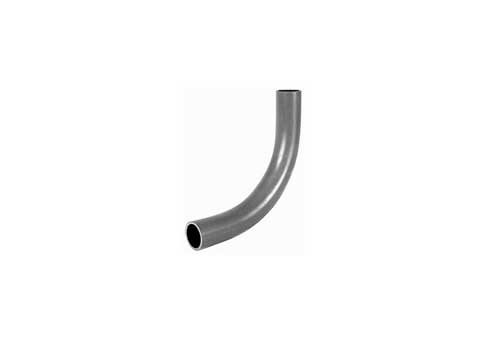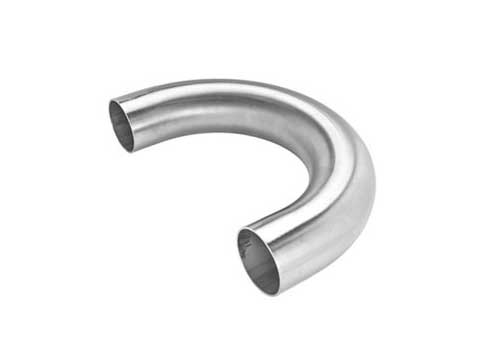Welcome to Kolkata Pipe Fittings, we are the most significant Long Radius Bend Manufacturers, Suppliers, Dealers, Stockist, Traders in Pune, Maharashtra Since 1994. One type of pipe fitting that's used to alter the direction of fluid flow in a piping system is the long radius bend. It can change direction more gradually than an ordinary or short-radius bend due to its higher curvature radius. The fluid flow's turbulence and pressure loss are reduced by this gradual direction change.
Nominal diameter (ND) and bend radius (R) are the usual variables used to determine the size of a long-radius bend. Typically, the bend radius is given as a multiple of the nominal diameter. For example, a 6D long radius bend has a bend radius that is six times the nominal diameter of the pipe.
Features of Long Radius Bends
- Smooth inner wall: In comparison to short radius bends, long radius bends have a smoother inner wall. The fluid passing through the pipe experiences less drag and friction thanks to this smooth surface, which lowers pressure loss.
- Decreased pressure drop: Compared to short radius bends, long radius bends result in a lower pressure drop in the flowing fluid because of the gradual direction change. This is significant for situations where it's necessary to maintain constant pressure.
- Reduced turbulence: The flowing fluid has less turbulence when long radius bends are bent gradually. Problems like cavitation, noise, and wall erosion in pipes can be brought on by turbulence.
- Resistance to high pressure and temperature: A variety of materials that are able to withstanding high pressure and temperature can be used to create long radius bends, which makes them suitable for a wide variety of applications.
- Versatility: To meet different piping system needs, We supply long radius bends in a range of sizes, angles (such as 45 degrees, 90 degrees, etc.), and materials.
- Easy installation: We manufacture, supply long radius bends depending on the type of fitting and application, long-radius bends can be made by flanging, threading, or welding.
Specifications of Long Radius Bend
- Nominal Pipe Size (NPS): This is the standard diameter of the pipes that the long radius bend is designed for. Ensuring the bend's NPS matches with the pipe it will be linked to is crucial.
-
Bend Radius (R): This is the most important dimensional specification of a long radius bend. It is frequently denoted by "D" and stated as a multiple of the nominal pipe size (D). Long radius bends typically have bend radii of 1.5D, 3D, 6D, or even greater.
- Although a wider bend radius takes additional space for installation, it results in a more gradual change in direction and smaller pressure loss.
- The bend radius that is chosen depends on the particular application as well as elements like flow rate, pressure requirements, and available space.
- Center-to-Faced Dimension (C2C): This is the distance that lies between the center line of the inlet and the outlet of the bend. Ensuring correct alignment during installation is crucial.
- Wall Thickness: A schedule number (Sch) typically serves to specify the wall thickness for a long radius bend. Long radius bends are generally scheduled using Sch 40, Sch 80, and Sch 160 schedules. The minimum wall thickness compared to the nominal pipe size is denoted by the schedule number.

Material Specifications

We as a leading Long Radius Bends Manufacturers, Suppliers use a range of materials that can create long radius bends that meet different requirements like corrosion resistance, temperature, and pressure. Common components consist of the following:
- Carbon steel: Carbon steel is commonly used due to it's excellent mechanical qualities, carbon steel is the material most frequently utilized for long radius bends. Ideal for applications requiring low to moderate pressure.
- Stainless Steel: Stainless steel has greater resistance to corrosion and can withstand greater temperatures compared to carbon steel frequently employed in situations where there are strict hygenic standards or corrosive fluid needs.
- Alloy Steel: Alloy Steel has excellent durability and it can stand with extreme temperatures and pressures. Utilized in vital installations like power plants and pipelines for gas and oil.
- Copper and Brass: These metals are commonly used for plumbing applications due to their good resistance to corrosion and workability.
Rating of Pressure
The greatest pressure that a long radius bend can securely stand at certain temperatures is indicated by its pressure rating. In general, pressure ratings are defined as pressure classes or pounds per square inch (psi). The substance, wall thickness, and bend design all influence the pressure rating. Selecting a long radius bend with a pressure rating that matches or exceeds the piping system's pressure requirements is essential.
Applications of Long Radius Bend
The applications of Long Radius Bend concentrate mainly on pipe fitting that's used to alter the direction of fluid flow in a piping system. We as a most significant Long Radius Bend Dealers, Stockist, Traders in Pune, Maharashtra supply products to various industries for various applications. Here are a few important areas of use:
- High-Pressure Systems: Consistent pressure management, it is essential in applications such as power plants, hydraulic systems, and oil and gas pipelines. High-pressure bends with a long radius are commonly used in minimizing pressure drops and guaranteeing efficient fluid flow.
- Low-Turbulence Applications: To avoid issues like corrosion, cavitation, and degradation of goods, industries such as chemical industries, food processing, and pharmaceutical manufacturing need low turbulence. Long radius bends provide a gradual direction change that minimizes turbulence and enables a smoother flow.
- Water Supply Systems: Water supply lines for homes, businesses, and irrigation systems frequently have long radius bends. By reducing pressure loss, they contribute to maintaining sufficient water pressure across the system.
- HVAC Systems: In air conditioning, ventilation, and heating systems, long radius bends increase effective airflow within ducts and pipes. In addition to providing suitable temperature management, this lowers energy usage.
- Shipbuilding and Marine Applications: In order to withstand saltwater and other deadly environments, long radius bends designed of corrosion-resistant materials, such as stainless steel, are utilized in shipbuilding and marine applications.
- Sanitary Piping Systems: Long radius bends built of sanitary materials, such as stainless steel, are used in hospitals, food processing manufacturing plants, and pharmaceutical organizations to preserve hygiene and prevent contamination. The inner walls' smooth surface reduces the possibility of bacterial growth.
- High-Temperature Applications: To handle fluids at high temperatures, such as in power plants and refineries, long radius bends are made from materials resistant to high temperatures, such as alloy steel.
We at Kolkata Pipe Fittings are leading Long Radius Bends Manufacturers, Suppliers, Dealers, Stockist, Traders in Pune, Maharashtra. Pipe fittings have a larger curvature than regular bends, known as long radius bends. It provides smoother turns and less pressure loss in fluid flow. They are ideal for high-pressure systems, water supply lines, HVAC systems, and applications needing high flow efficiency or low product degradation, where minimizing pressure drop and turbulence is important. Long radius bends are an adaptable choice for a variety of pipe systems because they may be made from a variety of materials to meet various requirements for temperature, pressure, and resistance to corrosion. Contact us today book your free consultation and come up with the best solution for your unique needs.